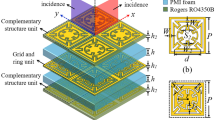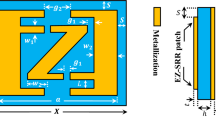Abstract
This paper presents, in the first part, an original topologie of dielectric resonators for multilayer filter applications in Ka band. The resonant element is defined by a partially metallized dielectric plate enclosed in a parallelepipedic cavity. This topology allows a high integration in a planar environment type and presents high electrical performances too. It is easily manufactured, and suitable for high frequencies filtering and power applications. In order to realize multipole filters without tuning, a direct electromagnetic optimization method developed in our laboratory is applied. This method combines a electromagnetic software based on the finite element method, and a specific one to establish the identified coupling matrix deducted from the filter responses. Some experiments are performed to verify the theoretical design.
In the second part, we consider a new global function which combines filtering and radiating characteristics. For the first time, an opened tuning less two-pole filter defined by two superposed resonators coupled by a metallic iris is designed. Its filtering and radiating functions are optimized in the same time to present required electrical performances.
Résumé
Cet article présente dans la première partie, des résonateurs diélectriques originaux pour la conception de filtres micro-ondes multiniveaux en bande Ka. Ľélément résonant est constitué par un substrat diélectrique partiellement métallisé et blindé dans une cavité parallélépipédique. Cette topologie permet une meilleure intégration dans un environnement planaire, tout en présentant des caractéristiques électriques performantes. Le résonateur est de réalisation aisée, et est destiné à du filtrage aux hautes fréquences et à des applications de puissance. Dans le but de concevoir des filtres multipôles sans réglages expérimentaux, une méthode directe ďoptimisation électromagnétique mise au point dans notre laboratoire est appliquée. Cette méthode comprend un logiciel ďanalyse électromagnétique basé sur la méthode des éléments finis et un logiciel spécifique permettant ďidentifier la matrice de couplage du filtre à partir de sa réponse. Des mesures sont effectuées pour confirmer la théorie.
Dans une seconde partie, une fonction globale combinant des caractéristiques de filtrage et de rayonnement est décrite. Pour la première fois, un filtre à 2 pôles sans réglage, rayonnant, est conçu sous la forme de deux résonateurs superposés, couplés par un iris métallique. Les fonctions de filtrage et de rayonnement sont optimisées globalement afin de satisfaire les caractéristiques électriques voulues.
Similar content being viewed by others
References
Ishikawa (Y.), Hiratsuka (T.), Yamashita (S.), Iio (K.), “Planar type dielectric resonator filter at millimeter-wave frequency”,IEICE Trans. Electron.,Vol. E79-C, 5, May 1996, pp. 679–684.
Hiratsuka (T.),Sonoda (T.),Mikami (S.),Sakamoto (K.),Takimoto (Y.), “A Ka-Band Diplexer Using Planar te Mode Dielectric Resonators with Plastic Package”,29 th European Microwave. Conference, Munich, Oct 1999
Bila (S.), Baillargeat (D.), Aubourg (M.), Verdeyme (S.), Guillon (P.), Zanchi (C.), Sombrin (J.), Grimm (J.), Barat-chart (L.), “Direct Electronic Optimization Method for Microwave Filter Design”,Electronics Letters,35, n° 5, pp. 400–401, March 1999
Aubourg (M.), Guillon (P.), “A miwed finite formulation of microwave devices problems: Application to mis structure”,J. Electromagn. Waves Applications,5, n° 415, pp. 371–386, 1991.
Nedelec (J.C.), “A new family of mixed elements on R3”,Numer. Math.,50, pp. 57–87, 1986.
Atia (A.E), Williams (A.E), “New types of waveguides bandpass filters satellite transponders”,COMSAT Tech. Rev, 1971,1, n° 1, pp. 21–43
Rouchaud (F.),Madrangeas (V.),Aubourg (M.),Guillon (P.),Theron (B.),Maignan (M.), “New Classes of Microstrips Resonators for hts Microwave Filter Applications”,ieee mtt-s, Baltimore, June 1998
Moraud (S.),Verdeyme (S.),Guillon (P.),Ulian (P.),Theron (B.), “A new planar type dielectric resonator for microwave filtering”,ieee mtt-s, Baltimore, June 1998
Alos (J.T.), Guglielmi (M.), “Simple and effective em-based optimization procedure for microwave filters”,ieee Transactions on mtt,45, n° 6, June 1997, pp. 856–858.
Atia (A.E.), Williams (A.E.), “Narrow-bandpass waveguide filters”,ieee Transactions on mtt,20, n° 4, April 1972, pp. 258–265
Baillargeat (D.),Moraud (S.),Blondeaux (H.),Bila (S.),Verdeyme (S.),Guillon (P.), “Design of filters for space applications”,Workshop mtt “Filter for the masses”, Anaheim, CA, June 13–19 1999
Harrington (R.F.), “Time Harmonic Electromagnetic Field”, McGraw-Hill, New York 1961, p. 34.
Author information
Authors and Affiliations
Corresponding author
Rights and permissions
About this article
Cite this article
Baillargeat, D., Blondeaux, H., Bila, S. et al. Computer aided design for new microwave filter topologies for spatial applications in Ka band. Ann. Télécommun. 56, 61–71 (2001). https://doi.org/10.1007/BF03002986
Received:
Accepted:
Issue Date:
DOI: https://doi.org/10.1007/BF03002986
Key words
- Computer aided design
- Microwave filter
- Space application
- Centimetric wave
- Dielectric resonator
- Electromagnetism
- Optimization
- Chebyshev filter
- Elliptic filter
- Radiating element




